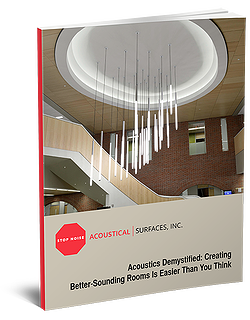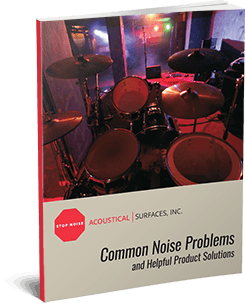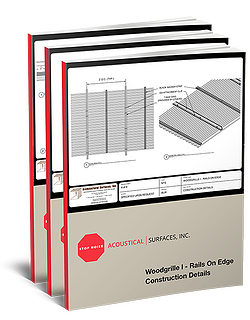Understanding the Acoustic Properties of Wood
Updated December 29, 2023
Whether you’re an architect designing a new concert hall or a contractor hired to expand a wing of an office, acoustics are a necessary component of any project. Acoustics encompasses everything from the transmission to the reception of sound, including its control over distortions and reverberating effects.3
Different materials facilitate balanced acoustics, meaning that to perfect your new project’s sound management from the start, you’ll need to consider how each material fares in acoustic performance.
So, is wood good for acoustics?
Wood is a popular sound management material for a variety of reasons. In this article, we’ll explore the acoustic properties of wood and highlight the best types to use architecturally.
Wood’s Architectural Uses
Historically, wood has been a go-to material for acoustically-aware architects. It’s been used in many famous buildings, including:
- The Vienna Musikverein – Home to the Vienna Philharmonic Orchestra, this famous concert hall features extensive wood paneling and flooring, providing it with its rich auditory warmth.2
- St. Paul’s Cathedral – Located in London, this stunning church features wood throughout its Gothic-style interior, allowing its choir to put on enchanting performances with outstanding sound quality.3
- The Globe Theatre – Also based in London, this theater has hosted many Shakespeare plays throughout the years. Thanks to its wood construction, its actors’ voices carry beautifully, even without modern amplifiers.4
Wood Acoustic Panels
If you want to emulate these world-renowned buildings, you can enhance your acoustics by working with wood, too.
One of the easiest ways to employ wood in your construction is with wood ceiling panels and wall panels. Acousticore 519 and 525 wall and ceiling panels, for example, provide pleasing design along with unmatched acoustic advantages.
The acoustic wood wall panel is lightweight, so they can be hung easily using standard Z-clips. Better yet, they can confidently withstand seasonal changes in temperature and humidity.
What Are the Vibrational Qualities of Wood?
When it comes to acoustic wall panels and ceiling panels, wood stands out for its:
- Sound absorption – Wood is a naturally porous material. Porous materials absorb sound by trapping sound waves in their pores and converting them into heat. Sound absorption is important because it can reduce background noise, echoes, and reverberation within a room.
- Controlled reflection – While wood is porous, it can also be quite hard and smooth. In turn, you can position the acoustic wood panels to reflect sound within a space strategically.
- Sound propagation – Proper sound propagation makes it easier for voices and instruments to be heard throughout a large space, such as a concert hall or theater. Wood acoustic panels do a fantastic job of propagating sound evenly, ensuring that even those in the back rows enjoy a vibrant auditory experience.
- Resonance – Resonance is a material’s ability to produce sound waves in response to other sound waves. Wood has a naturally warm, rich resonance. It emits this resonance when it interacts with other sounds, elevating a room’s ambiance.
Pros & Cons of Wood Acoustics
In addition to the acoustic properties of wood outlined above, wooden acoustic panel also stands out for its:
- Durability
- Versatility
- Aesthetic appeal
- Customizability
Wood may seem like it can do it all. Yet despite wood’s acoustic benefits, it also has some potential downsides to consider for your project:
- Cost – A wood acoustic panel can be more expensive than another type of sound absorbing material.
- Maintenance – Some types of wood may need to be refinished and resealed from time to time.
- Environmental sensitivity – Some acoustic wood panels may warp in the face of seasonal heat and humidity. Fortunately, the Acousticore 519 and 525 sound absorbing panels are a notable exception.
- Limited soundproofing –Wood is an excellent sound absorber, but it doesn’t offer as much sound containment as heavier materials, such as concrete or brick. However, it can be used in conjunction with these materials to provide the best of both worlds. It might help you decide whether wood is a great option once you learn more about the difference between soundproofing vs sound absorbing.
- Flammability – As a flammable material, wood should be treated with fire retardants to ensure adequate fire safety. The Acousticore 519 and 525 wooden acoustic panels boast a Class A (ASTM-E84) Fire Rating.
Types of Wood and Their Acoustic Properties
While wood is good for acoustics, some species of wood provide better sound quality than others. Here’s a brief overview:
- Softwoods – Softwoods, such as pine and spruce, are lightweight and have a relatively low density. As a result, they absorb sound better than their hardwood counterparts.
- Hardwoods – Hardwoods, on the other hand, are heavier and denser. While slightly less sound absorbent, these woods are highly durable. Some examples of hardwoods are oak, mahogany, and maple.
- Engineered woods – Plywood, medium-density fiberboard (MDF), and other engineered woods are constructed with wood fibers and adhesives. Depending on their density, they can either absorb or block sound.
Consider Using Titebond Acoustical Sealant
If you want to use wood in your next project, GREENchoice™ Acoustical Sound Sealant is an environmentally safe, VOC-compliant option. It’s also non-flammable, easy to use, and mold- and mildew-resistant. By sealing air gaps, this sealant can prevent sound transmission between partition systems and enhance your building’s sound quality.
Acoustical Surfaces: Experience the Advantages of Wood Acoustics
So, does wood acoustic panel work? Yes—thanks to wood’s unique acoustic properties, it’s a worthwhile architectural material. You just need to select the right acoustic wood wall panel for your project.
If you need help, the sound experts at Acoustical Surfaces can set you up with the right solutions. We have over 35 years of experience supporting architects and contractors with all of their sound-related needs.
Sources:
- BYU. What is Acoustics? https://acoustics.byu.edu/what-is
- EuroNews. What’s the secret behind the Vienna Philharmonic’s unique sound? https://www.euronews.com/culture/2022/06/16/viennese-sound-the-secrets-behind-one-of-the-world-s-great-orchestras
- Grinling Gibbons Photos. Saint Paul’s Cathedral.https://www.grinlinggibbonsphotos.com/saint-pauls-cathedral/
- Shakespeare’s Globe. #WorldTheatreDay. https://www.shakespearesglobe.com/discover/blogs-and-features/2020/03/27/worldtheatreday/




